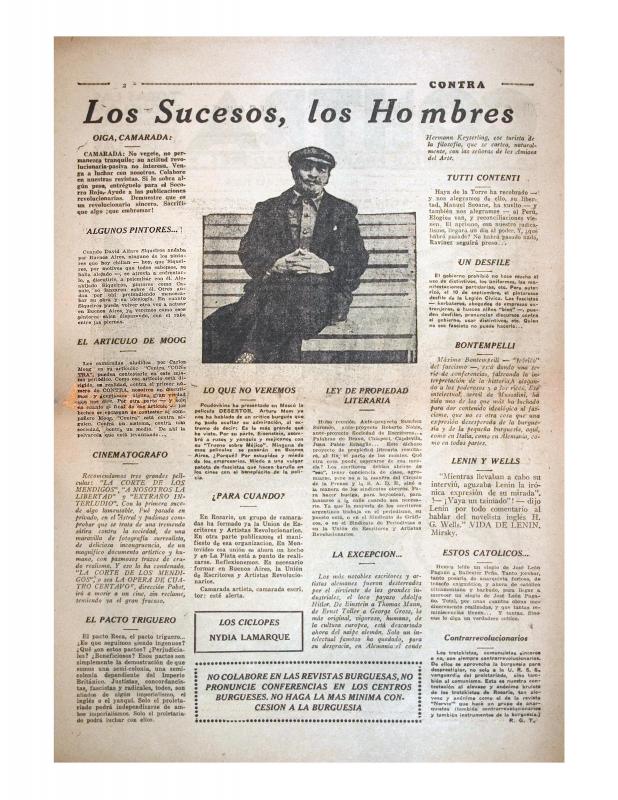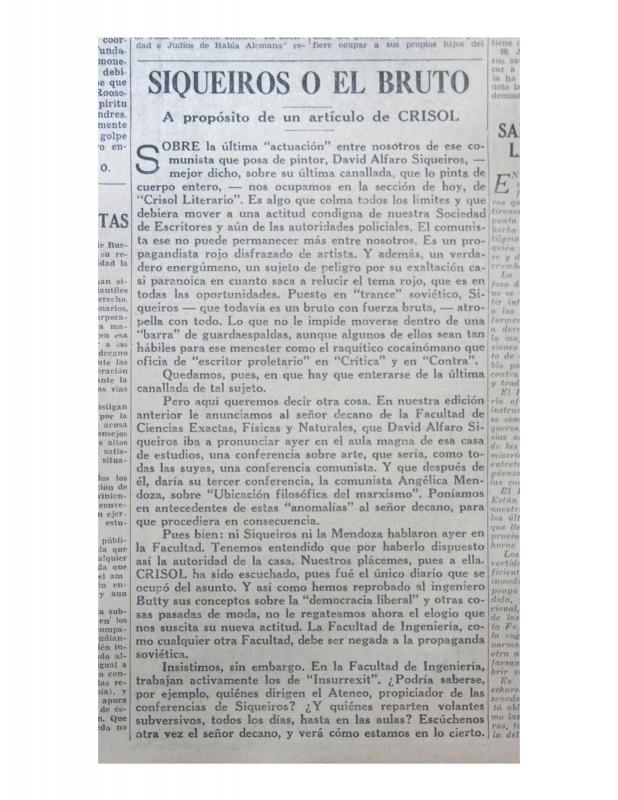Having been expelled from the United States, David Alfaro Siqueiros (1896–1974) traveled to Montevideo in February of 1933, and by the end of May in that same year he had established himself in Buenos Aires. In the River Plate, Siqueiros experimented with technique and presented arguments based on the contents of his lecture Los vehículos de la pintura dialéctico-subversiva [The Vehicles of Dialectical-Subversive Painting], which he haddeveloped while in the United States. In June he exhibited in Buenos Aires at Amigos del Arte [Friends of Art], a liberal and modernizing arts institution. He gave controversial lectures that polarized the arts field into the defenders of “arte puro” [“pure art”] and “arte político”[“political art”]. He was supported by Contra. La revista de los francotiradores [Against: The Snipers’ Magazine], run by the leftist writerRaúl González Tuñón [see documents 733230, 733314, and 733270, among others]. Siqueiros collaborated on the newspaper Crítica [Critique], run by Natalio Botana. Botana commissioned Siqueiros to paint a mural in the cellar of his house, Quinta Los Granados, in Don Torcuato, in the Province of Buenos Aires. The Equipo Poligráfico Ejecutor [Lead Polygraphic Team]—formed by Siqueiros, Antonio Berni (1905–1981), Lino Enea Spilimbergo (1896–1964), Juan Carlos Castagnino (1908–1972), and the Uruguyan set-designer Enrique Lázaro—created Ejercicio Plástico [Visual Exercise], with distorted nudes over the curved surface of the vaulted ceiling, by means of photographic projection. It was conceived as a fresco on cement, using such technical innovations as application by mechanical tools and the use of industrial silicates. In December 1933, sketches and photographs of the mural were exhibited in the magazine Signo [Sign] premises. Currently the work is in storage due to litigation; damage may affect its conservation. At that time, Argentinean right-wingers strongly attacked the Mexican Communist painter within its publications Bandera Argentina [Argentinean Flag] and Crisol [Melting pot], which were representative of the Catholic nationalism that had gained strong momentum since the military coup of 1930 [see documents 733206, 734077, and 733182, among others]. Signo [Sign] was a publication run by the art critic Leonardo Estarico. In June 1933 Siqueiros delivered a controversial lecture at the Signo art gallery, and in December of 1933, sketches and engravings of the mural Ejercicio Plástico [Visual Exercise] were exhibited. This document is one of a group of news items published in Signo [Sign] that reported on the activities of Siqueiros in Buenos Aires from the perspective of a magazine important to the circulation of information within the Argentinean art scene. The magazine did not take sides in the debates, but rather was simply an unbiased source of the controversy.






